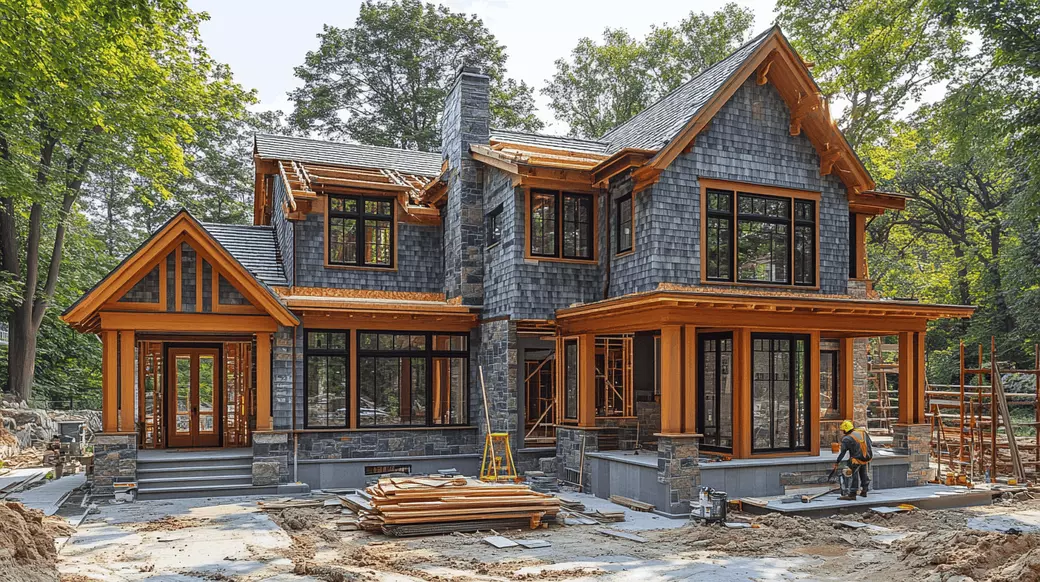Beat the Competition: 5 Buyer Tips for Low Inventory in Nassau & Suffolk

Hello, and welcome back to Dream Select Realty’s series on the Long Island real estate market! Today, we are talking about inventory and supply in Nassau and Suffolk Counties. If you’ve been following local real estate trends, you probably already know that Long Island can sometimes face a limited housing supply, making it challenging for buyers to find their dream home and for sellers to manage all the attention (and sometimes stress) that comes with a “seller’s market.”
But what does limited housing supply mean for you? How can buyers navigate fewer listings without settling for less than what they want? What about new construction, and how is it shaping Nassau and Suffolk’s neighborhoods? And have you heard about the trend of converting commercial spaces into residential ones? We’ll explore all of these topics in depth.
By the end of this article, you’ll have a clearer idea of how to handle the low inventory situation, whether you’re a buyer, a seller, or simply curious about the changing landscape of Long Island’s suburbs. From strategies to cope with limited supply to the latest in new construction trends and even the conversion of commercial properties, Dream Select Realty has you covered. Let’s dive in!
Part 1: Understanding the Housing Supply Challenge in Nassau and Suffolk
What Does “Limited Inventory” Mean?
When we say the real estate market has “limited inventory” or a “tight supply,” we mean there aren’t enough homes on the market to meet demand. In other words, lots of buyers are looking, but fewer sellers are listing their homes. This can drive up prices and create competition among buyers. Often, multiple offers come in for a single listing, and homes may sell faster than usual.
Nassau and Suffolk Counties have seen this pattern for several years. As more people move to the suburbs—some for more space, others for good schools or to be closer to family—there simply aren’t enough houses to go around. This makes the market very competitive and can lead to frustration for those who are unprepared.
Key Reasons for Low Supply on Long Island
- Desirable Location: Long Island offers a mix of suburban charm, good schools, and relatively close proximity to New York City. Many people want to live here.
- Limited Space: Nassau and Suffolk, while large, have certain zoning laws and geographic constraints (such as protected wetlands) that limit how much new housing can be built.
- People Staying Put: Low interest rates in recent years encouraged many homeowners to refinance and stay longer in their homes. If people aren’t selling, it shrinks the number of houses on the market.
- High Demand: In many neighborhoods, demand outpaces supply, resulting in rising home prices. Some buyers are even priced out of certain areas, increasing competition for more affordable properties.
At Dream Select Realty, we watch these trends closely, so we can guide our clients through each phase of the buying or selling process. Whether you’re searching for a cozy starter home or a spacious property, understanding the reality of limited inventory is the first step.
Part 2: Strategies for Buyers in a Limited Inventory Market
If you’re a buyer in Nassau or Suffolk, don’t worry—there are ways to handle this competitive environment. It helps to be prepared and work with a real estate team that understands local markets.
1. Get Pre-Approved for a Mortgage
One of the best ways to stand out as a buyer is to have a mortgage pre-approval letter in hand. This shows sellers that your financing is likely secure and that you’re serious about making an offer. Pre-approval also helps you know exactly what you can afford, so you don’t waste time looking at homes outside your price range.
2. Be Ready to Act Fast
In a hot market, homes can get multiple offers in just a day or two. If you see a property you love, be prepared to schedule a showing as soon as possible. Also, check listings regularly or set up alerts through your real estate agent or online platforms. This ensures you don’t miss out on new properties that appear.
3. Consider Expanding Your Search
Sometimes, buyers get set on a particular neighborhood or type of home. While it’s great to have a wish list, being flexible can help you find hidden gems. You could look at surrounding neighborhoods, consider homes that need light renovations, or open up your search to different styles (like a split-level if you were originally focused on a ranch). With fewer listings overall, a little flexibility can make a big difference.
4. Make a Strong, Competitive Offer
In a seller’s market, lowball offers rarely work. If a home is priced fairly, offering near or above the asking price might be needed to compete. Your Dream Select Realty agent can help you understand what similar homes have sold for, so you can make a well-informed offer.
5. Add a Personal Touch
It might seem old-fashioned, but a personal letter to the seller can sometimes tip the scales in your favor. By explaining why you love their home and how you plan to take care of it, you can stand out among other buyers. Just remember to keep it heartfelt but brief.
Part 3: Strategies for Sellers in a Tight Market
When there’s limited inventory, sellers hold more power. Homes often sell quickly, and sometimes above the listing price. However, that doesn’t mean every sale is perfect without planning. Here are a few ways sellers can make the most of a tight market in Nassau and Suffolk.
1. Price Your Home Strategically
It can be tempting to set a high price just because the market is hot. But pricing your home too high can scare off buyers or lead to a longer listing time. Overpriced homes can become “stale” if they sit on the market for too long. By pricing correctly—sometimes slightly below market value—you can spark more interest and potentially create a bidding war.
2. Prepare Your Home for Sale
Even in a seller’s market, you want your home to look its best. Declutter, deep clean, and consider staging to show off your property’s potential. Fix minor issues like leaky faucets or chipped paint, because buyers can be picky, even when inventory is low. The better your home shows, the more likely you’ll get strong offers quickly.
3. Set a Timeline That Works for You
If your home is likely to sell quickly, make sure you have a plan for where you’ll go next. Whether you’re moving into a bigger home, downsizing, or relocating out of state, talk to your Dream Select Realty agent about timelines. That way, you won’t feel rushed if multiple offers come in sooner than you expected.
4. Keep Emotions in Check
Selling a home can be emotional, especially if you’ve lived there for many years. When the offers start rolling in, keep a clear head. Your agent will help you compare each offer—not just by price, but by financing terms, contingencies, and closing timelines. This helps you pick the best overall offer for your situation.
Part 4: New Construction Trends in Nassau and Suffolk
While limited inventory is largely about existing homes, new construction also plays a big part in housing supply. Builders on Long Island continue to look for ways to bring fresh housing options to meet the high demand. Let’s explore some of the recent trends.
1. Mixed-Use Developments
Mixed-use developments combine residential, commercial, and sometimes office spaces in one area. These developments are popping up more frequently in areas that want to make the most of limited land. Instead of building just a block of apartments, for example, a mixed-use project might include stores, restaurants, and shared public spaces. Residents can walk to shops and cafés, creating a more urban, walkable feel.
2. Smaller, Efficient Homes
Not everyone wants—or can afford—a large suburban house. Builders are responding by offering townhouses, condos, and even tiny home communities in some parts of the country. On Long Island, the push for smaller homes is growing, especially as first-time buyers or empty nesters look for more budget-friendly options. Plus, smaller homes can be more energy efficient and easier to maintain.
3. Sustainability and Green Building
Sustainable building practices are also a trend among new construction. Energy-efficient windows, solar panels, and eco-friendly materials help reduce carbon footprints and utility costs. As we covered in our previous article on sustainable development, many communities in Nassau and Suffolk are adopting greener practices to protect the environment and keep housing more affordable in the long run.
4. Community Amenities
Homebuilders are also focusing on creating neighborhoods with community-oriented amenities. This might include clubhouses, shared green spaces, fitness centers, or pools. Such features attract buyers who want more than just a house—they want a lifestyle. For younger families, having playgrounds or safe walking paths is a big plus.
5. Challenges for New Construction
Of course, new construction faces some obstacles on Long Island. Zoning regulations, limited available land, and environmental protections can slow or halt certain projects. Additionally, construction costs have risen, influenced by the price of building materials, labor shortages, and inflation. Despite these challenges, many builders see great potential in meeting the needs of buyers who are frustrated by the tight resale market.
Part 5: Conversion of Commercial to Residential Spaces on Long Island
One interesting trend that could help increase housing supply is the conversion of commercial buildings into residential units. After recent economic shifts, some office buildings, retail spaces, or warehouses are underused or vacant. Converting these properties can help fill the demand for housing while also revitalizing empty spaces.
1. Why Convert Commercial Properties?
- Location: Many commercial properties are in downtown or high-traffic areas, which can be attractive for those who want easy access to shops, restaurants, and public transportation.
- Revitalization: Turning a neglected mall or office building into apartments or condos can breathe new life into an area.
- Efficiency: It’s often cheaper and faster to retrofit an existing building than to start from scratch. Builders can reuse the foundation and structure, cutting down on construction time.
2. Challenges in Commercial Conversions
- Zoning Regulations: Commercial buildings may not be zoned for residential use. Developers need approval from local governments, which can be time-consuming.
- Building Requirements: A commercial building might need significant interior changes to meet safety codes for residential living. This could include plumbing, electric, and ventilation upgrades.
- Market Demand: Not every location is ideal for residential use. Developers must research whether people actually want to live in that area.
Despite these challenges, commercial conversions are an exciting option that can add more housing to Nassau and Suffolk. Dream Select Realty keeps an eye on these projects because they can offer unique opportunities for buyers interested in modern layouts or city-style living in the suburbs.
Part 6: The Role of Real Estate Agents in Navigating Limited Supply
In a market where listings can be scarce, having a knowledgeable real estate agent is more important than ever. Here’s how Dream Select Realty helps both buyers and sellers:
1. Market Knowledge
We live and breathe the local market trends in Nassau and Suffolk. We know which neighborhoods are seeing the most activity, where prices are stable or rising, and what features buyers value most. This helps us advise you on everything from listing prices to which homes are worth a speedy offer.
2. Networking
Great agents have networks of other agents, contractors, and professionals. If a home hasn’t even hit the market yet, we might hear about it through our connections. This can give our clients a first look, which can be critical when listings move fast.
3. Negotiation Skills
From crafting an offer that grabs a seller’s attention to negotiating repairs or contingencies, a skilled agent protects your interests. In a tight market, sellers might receive several offers, so it’s crucial to have an agent who knows how to stand out in a respectful, strategic way.
4. Access to Resources
We can connect you to lenders who will help you get pre-approved quickly, home inspectors who can do a thorough job under tight timelines, and attorneys who understand the complexities of Long Island real estate. This coordinated approach helps transactions run smoothly, even when time is of the essence.
Part 7: Tips for Navigating Low Inventory Successfully
1. Be Prepared to Compromise
In a perfect world, you’d find the house that meets 100% of your “wish list” at the right price. In reality, you might need to compromise on certain features—like a smaller yard or an older kitchen—to secure a home. Think about your true deal-breakers and what you can reasonably live with.
2. Move Quickly but Carefully
Yes, you need to be ready to make quick decisions, but don’t skip important steps like inspections or reading over the contract thoroughly. A rushed purchase could lead to surprises down the road. Work with your agent to move efficiently without missing essential details.
3. Explore Mortgage Options
When interest rates are in flux, having the right mortgage can save you thousands of dollars over the life of your loan. Research different loan types (like conventional, FHA, or VA loans) and see which ones fit your situation. A good lender will explain all fees and help you compare rates to find the best deal.
4. Monitor the Market
Markets can shift. Sometimes, new listings might appear at once, and sometimes, inventory gets even tighter. Stay in touch with your agent, set up alerts, and keep track of how prices and days on market are changing in your target areas.
Part 8: Looking Ahead—The Future of Inventory on Long Island
While nobody can predict the future with 100% certainty, there are signs that Nassau and Suffolk Counties will continue to see strong demand for homes. The area’s many amenities, from beaches and parks to top-rated schools, draw people who want a suburban lifestyle within commuting distance of New York City.
Possible shifts in inventory could come from changing economic conditions, updated zoning laws that support more construction, or new developments in underused areas (like certain parts of Suffolk County that still have available land). The commercial-to-residential conversion trend might continue, especially if remote work remains popular, reducing the need for large office buildings.
Dream Select Realty stays on top of these trends to help our clients plan ahead. If you’re a buyer, we can help you position yourself wisely in a competitive market. If you’re a seller, we can guide you in timing your sale to get the best possible outcome. And if you’re an investor or developer, we can show you promising opportunities, such as areas ripe for new construction or conversion projects.
Conclusion
Navigating a limited housing supply in Nassau and Suffolk Counties doesn’t have to be stressful—especially when you have the right knowledge and support. Whether you’re a buyer adapting to a competitive market, a seller looking to maximize your home’s value, or a developer exploring new construction or conversion opportunities, it’s crucial to understand how inventory shapes your real estate journey.
Throughout this article, we’ve discussed strategies to handle low supply, from getting pre-approved and making strong offers (as a buyer) to pricing right and preparing your home for sale (as a seller). We’ve looked at new construction trends, including mixed-use developments and smaller, more efficient homes, as well as the conversion of commercial spaces into residential units. These changes provide potential relief to the tight market while helping communities grow in new ways.
At Dream Select Realty, we understand that knowledge is power. Our team is here to guide you, answer your questions, and help you seize the opportunities that come with living or investing on Long Island. If you have any concerns about housing availability or if you’re curious about upcoming listings and projects, don’t hesitate to reach out. We’re committed to helping you make the best real estate decisions—no matter how the market shifts.
Thank you for joining us in this deep dive into inventory and supply on Long Island. Remember, staying informed is half the battle, and the Dream Select Realty team is here to support you every step of the way.
Categories
Recent Posts










